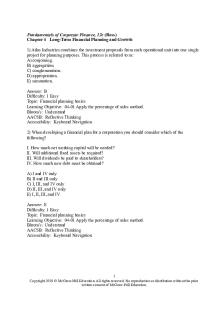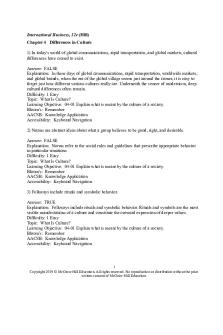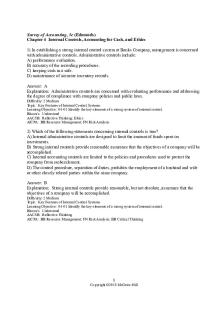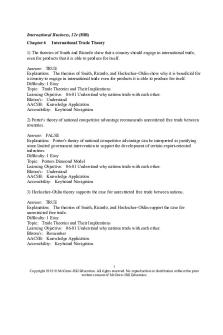Ross12e Chapter 04 TB Answer Key PDF

| Title | Ross12e Chapter 04 TB Answer Key |
|---|---|
| Author | Nelson Veras |
| Course | Financial Management |
| Institution | University of South Florida |
| Pages | 56 |
| File Size | 306.6 KB |
| File Type | |
| Total Downloads | 2 |
| Total Views | 213 |
Summary
This is the TB answer key for Chapter 04 of the Fundamentals of Corporate Finance 12th edition Ross, Westerfield, and Jordan...
Description
Fundamentals of Corporate Finance, 12e (Ross) Chapter 4 Long-Term Financial Planning and Growth 1) Atlas Industries combines the investment proposals from each operational unit into one single project for planning purposes. This process is referred to as: A) conjoining. B) aggregation. C) conglomeration. D) appropriation. E) summation. Answer: B Difficulty: 1 Easy Topic: Financial planning basics Learning Objective: 04-01 Apply the percentage of sales method. Bloom's: Understand AACSB: Reflective Thinking Accessibility: Keyboard Navigation 2) When developing a financial plan for a corporation you should consider which of the following? I. How much net working capital will be needed? II. Will additional fixed assets be required? III. Will dividends be paid to shareholders? IV. How much new debt must be obtained? A) I and IV only B) II and III only C) I, III, and IV only D) II, III, and IV only E) I, II, III, and IV Answer: E Difficulty: 1 Easy Topic: Financial planning basics Learning Objective: 04-01 Apply the percentage of sales method. Bloom's: Understand AACSB: Reflective Thinking Accessibility: Keyboard Navigation
1 Copyright 2019 © McGraw-Hill Education. All rights reserved. No reproduction or distribution without the prior written consent of McGraw-Hill Education.
3) Financial planning: A) focuses solely on the short-term outlook for a firm. B) is a process that firms employ only when major changes to a firm's operations are anticipated. C) is a process that firms undergo once every five years. D) considers multiple options and scenarios. E) provides minimal benefits for firms that are highly responsive to economic changes. Answer: D Difficulty: 1 Easy Topic: Financial planning basics Learning Objective: 04-01 Apply the percentage of sales method. Bloom's: Understand AACSB: Reflective Thinking Accessibility: Keyboard Navigation 4) Financial planning includes the: I. determination of asset requirements. II. development of contingency plans. III. establishment of priorities. IV. analysis of funding options. A) I and III only B) II and IV only C) I, III, and IV only D) I, II, and III only E) I, II, III, and IV Answer: E Difficulty: 1 Easy Topic: Financial planning basics Learning Objective: 04-01 Apply the percentage of sales method. Bloom's: Understand AACSB: Reflective Thinking Accessibility: Keyboard Navigation
2 Copyright 2019 © McGraw-Hill Education. All rights reserved. No reproduction or distribution without the prior written consent of McGraw-Hill Education.
5) When planning for the long run, the planning horizon is usually a period of: A) 5 to 10 years. B) 2 to 5 years. C) 1 to 3 years. D) 3 to 7 years. E) 5 years or more. Answer: B Difficulty: 1 Easy Topic: Financial planning basics Learning Objective: 04-01 Apply the percentage of sales method. Bloom's: Remember AACSB: Reflective Thinking Accessibility: Keyboard Navigation 6) Which of the following questions are appropriate to address during the financial planning process? I. Should the firm merge with a competitor? II. Should additional shares of stock be sold? III. Should a particular division be sold? IV. Should a new product be introduced? A) I only B) II and III only C) I and II only D) I, II, and III only E) I, II, III, and IV Answer: E Difficulty: 1 Easy Topic: Financial planning basics Learning Objective: 04-01 Apply the percentage of sales method. Bloom's: Understand AACSB: Reflective Thinking Accessibility: Keyboard Navigation
3 Copyright 2019 © McGraw-Hill Education. All rights reserved. No reproduction or distribution without the prior written consent of McGraw-Hill Education.
7) Financial plans: A) concentrate solely on income and expense items. B) often contain alternative options based on economic developments. C) frequently contain conflicting goals. D) assume that firms obtain no additional external financing. E) are based on a single set of economic assumptions. Answer: B Difficulty: 1 Easy Topic: Financial planning basics Learning Objective: 04-01 Apply the percentage of sales method. Bloom's: Understand AACSB: Reflective Thinking Accessibility: Keyboard Navigation 8) Which one of the following are you most apt to estimate first as you begin the process of preparing pro forma statements? A) Need for additional fixed assets B) Current fixed costs C) Projected sales D) Desired net income E) Desired dividend payments Answer: C Difficulty: 1 Easy Topic: Pro forma statements Learning Objective: 04-01 Apply the percentage of sales method. Bloom's: Understand AACSB: Reflective Thinking Accessibility: Keyboard Navigation 9) Pro forma statements: A) must assume that no new equity is issued. B) are projections, not guarantees. C) are limited to a balance sheet and income statement. D) must assume that no dividends will be paid. E) exclude net working capital needs. Answer: B Difficulty: 1 Easy Topic: Pro forma statements Learning Objective: 04-01 Apply the percentage of sales method. Bloom's: Understand AACSB: Reflective Thinking Accessibility: Keyboard Navigation 4 Copyright 2019 © McGraw-Hill Education. All rights reserved. No reproduction or distribution without the prior written consent of McGraw-Hill Education.
10) The retention ratio can be computed as: A) 1 − Plowback ratio. B) Change in retained earnings/Cash dividends. C) 1 + Dividend payout ratio. D) (Change in retained earnings + Cash dividends)/Net income. E) 1 − (Cash dividends/Net income). Answer: E Difficulty: 1 Easy Topic: Financial planning basics Learning Objective: 04-01 Apply the percentage of sales method. Bloom's: Understand AACSB: Reflective Thinking Accessibility: Keyboard Navigation 11) The financial planning method that uses the projected sales level as the basis for determining changes in balance sheet and income statement account values is referred to as the ________ method. A) percentage of sales B) sales dilution C) sales reconciliation D) common-size E) trend Answer: A Difficulty: 1 Easy Topic: Financial planning models Learning Objective: 04-01 Apply the percentage of sales method. Bloom's: Remember AACSB: Reflective Thinking Accessibility: Keyboard Navigation 12) The portion of net income that a firm reinvests in itself is called the: A) retention ratio. B) dividend yield. C) dividend payout ratio. D) internal growth rate. E) cash influx ratio. Answer: A Difficulty: 1 Easy Topic: Financial planning basics Learning Objective: 04-01 Apply the percentage of sales method. Bloom's: Remember AACSB: Reflective Thinking Accessibility: Keyboard Navigation 5 Copyright 2019 © McGraw-Hill Education. All rights reserved. No reproduction or distribution without the prior written consent of McGraw-Hill Education.
13) Which ratio identifies the amount of total assets a firm needs in order to generate $1 in sales? A) Return on assets B) Equity multiplier C) Retention ratio D) Capital intensity ratio E) Current ratio Answer: D Difficulty: 1 Easy Topic: Asset management ratios Learning Objective: 04-01 Apply the percentage of sales method. Bloom's: Remember AACSB: Reflective Thinking Accessibility: Keyboard Navigation 14) When utilizing the percentage of sales approach, managers: A) estimate company sales based on a desired level of net income and the current profit margin. B) consider only those assets that vary directly with sales. C) consider the current production capacity level. D) can project net income but not net cash flows. E) assume all liability accounts will remain constant. Answer: C Difficulty: 1 Easy Topic: Financial planning models Learning Objective: 04-01 Apply the percentage of sales method. Bloom's: Understand AACSB: Reflective Thinking Accessibility: Keyboard Navigation 15) Which one of the following is correct in relation to pro forma statements? A) Fixed assets must increase if sales are projected to increase. B) Net working capital is affected only when a firm's sales are expected to exceed the firm's current production capacity. C) The addition to retained earnings is equal to net income less cash dividends. D) Long-term debt varies directly with sales when a firm is currently operating at maximum capacity. E) Inventory changes are not proportional to sales changes. Answer: C Difficulty: 1 Easy Topic: Financial planning models Learning Objective: 04-01 Apply the percentage of sales method. Bloom's: Understand AACSB: Reflective Thinking Accessibility: Keyboard Navigation 6 Copyright 2019 © McGraw-Hill Education. All rights reserved. No reproduction or distribution without the prior written consent of McGraw-Hill Education.
16) When constructing a pro forma statement, net working capital generally: A) remains fixed. B) varies only if the firm is currently producing at full capacity. C) varies only if the firm maintains a fixed debt-equity ratio. D) varies only if the firm is producing at less than full capacity. E) varies proportionally with sales. Answer: E Difficulty: 1 Easy Topic: Pro forma statements Learning Objective: 04-01 Apply the percentage of sales method. Bloom's: Understand AACSB: Reflective Thinking Accessibility: Keyboard Navigation 17) A pro forma statement indicates that both sales and fixed assets are projected to increase by 7 percent over their current levels. Given this, you can safely assume the firm: A) is projected to grow at the internal rate of growth. B) is projected to grow at the sustainable rate of growth. C) currently has excess capacity. D) is currently operating at full capacity. E) retains all of its net income. Answer: D Difficulty: 1 Easy Topic: Pro forma statements Learning Objective: 04-01 Apply the percentage of sales method. Bloom's: Understand AACSB: Reflective Thinking Accessibility: Keyboard Navigation
7 Copyright 2019 © McGraw-Hill Education. All rights reserved. No reproduction or distribution without the prior written consent of McGraw-Hill Education.
18) A firm is currently operating at full capacity. Net working capital, costs, and all assets vary directly with sales. The firm does not wish to obtain any additional equity financing. The dividend payout ratio is constant at 40 percent. If the firm has a positive external financing need, that need will be met by: A) accounts payable. B) long-term debt. C) fixed assets. D) retained earnings. E) common stock. Answer: B Difficulty: 1 Easy Topic: External financing need Learning Objective: 04-02 Compute the external financing needed to fund a firm's growth. Bloom's: Understand AACSB: Reflective Thinking Accessibility: Keyboard Navigation 19) When compiling a pro forma statement, which policy most directly affects the projection of the retained earnings account balance? A) Net working capital policy B) Capital structure policy C) Dividend policy D) Capital budgeting policy E) Capacity utilization policy Answer: C Difficulty: 1 Easy Topic: Pro forma statements Learning Objective: 04-01 Apply the percentage of sales method. Bloom's: Understand AACSB: Reflective Thinking Accessibility: Keyboard Navigation
8 Copyright 2019 © McGraw-Hill Education. All rights reserved. No reproduction or distribution without the prior written consent of McGraw-Hill Education.
20) Next year's pro forma statement is based on an annual increase in sales of four percent. The firm is currently operating at 85 percent of capacity. Net working capital and all costs vary directly with sales. The tax rate and the dividend payout ratio are fixed. Given this information, the: A) projected dividends must equal the current dividends. B) depreciation expense will decrease by four percent. C) retained earnings will increase by 85 percent of projected net income. D) total assets will increase by less than four percent. E) total liabilities and owners' equity will increase by four percent. Answer: D Difficulty: 1 Easy Topic: Pro forma statements Learning Objective: 04-01 Apply the percentage of sales method. Bloom's: Understand AACSB: Reflective Thinking Accessibility: Keyboard Navigation 21) A firm is operating at 90 percent of capacity. This information is primarily needed to project which one of the following account values when compiling pro forma statements? A) Sales B) Cost of goods sold C) Accounts receivable D) Fixed assets E) Long-term debt Answer: D Difficulty: 1 Easy Topic: Pro forma statements Learning Objective: 04-01 Apply the percentage of sales method. Bloom's: Understand AACSB: Reflective Thinking Accessibility: Keyboard Navigation
9 Copyright 2019 © McGraw-Hill Education. All rights reserved. No reproduction or distribution without the prior written consent of McGraw-Hill Education.
22) Which capital intensity ratio indicates the smallest need for fixed assets per dollar of sales? A) .07 B) .86 C) .39 D) 1.00 E) 1.15 Answer: A Difficulty: 1 Easy Topic: Asset management ratios Learning Objective: 04-01 Apply the percentage of sales method. Bloom's: Understand AACSB: Reflective Thinking Accessibility: Keyboard Navigation 23) Martin Aerospace is currently operating at full capacity based on its current level of assets. Sales are expected to increase by 4.5 percent next year, which is the firm's internal rate of growth. Net working capital and operating costs are expected to increase directly with sales. The interest expense will remain constant at its current level. The tax rate and the dividend payout ratio will be held constant. Current and projected net income is positive. Which one of the following statements is correct regarding the pro forma statement for next year? A) The pro forma profit margin is equal to the current profit margin. B) Retained earnings will increase at the same rate as sales. C) Total assets will increase at the same rate as sales. D) Long-term debt will increase in direct relation to sales. E) Owners' equity will remain constant. Answer: C Difficulty: 1 Easy Topic: Pro forma statements Learning Objective: 04-01 Apply the percentage of sales method. Bloom's: Understand AACSB: Reflective Thinking Accessibility: Keyboard Navigation
10 Copyright 2019 © McGraw-Hill Education. All rights reserved. No reproduction or distribution without the prior written consent of McGraw-Hill Education.
24) A firm's external financing need is met by: A) retained earnings. B) net working capital and retained earnings. C) net income and retained earnings. D) debt or equity. E) owners' equity, including retained earnings. Answer: D Difficulty: 1 Easy Topic: External financing need Learning Objective: 04-02 Compute the external financing needed to fund a firm's growth. Bloom's: Understand AACSB: Reflective Thinking Accessibility: Keyboard Navigation 25) Wood Products is operating at 87 percent capacity and earning a substantial profit. A sales increase is least apt to increase the firm's: A) accounts receivable. B) cost of goods sold. C) accounts payable. D) fixed assets. E) inventory. Answer: D Difficulty: 1 Easy Topic: Financial planning and forecasting Learning Objective: 04-01 Apply the percentage of sales method. Bloom's: Understand AACSB: Reflective Thinking Accessibility: Keyboard Navigation 26) The external financing need: A) will limit growth if unfunded. B) is unaffected by the dividend payout ratio. C) must be funded by long-term debt. D) ignores any changes in retained earnings. E) considers only the required increase in fixed assets. Answer: A Difficulty: 1 Easy Topic: External financing need Learning Objective: 04-02 Compute the external financing needed to fund a firm's growth. Bloom's: Understand AACSB: Reflective Thinking Accessibility: Keyboard Navigation
11 Copyright 2019 © McGraw-Hill Education. All rights reserved. No reproduction or distribution without the prior written consent of McGraw-Hill Education.
27) Worthington Industries is currently operating at full-capacity sales. Thus, sales are currently being limited by the firm's: A) net working capital. B) long-term debt. C) inventory. D) fixed assets. E) debt-equity ratio. Answer: D Difficulty: 1 Easy Topic: Financial planning and forecasting Learning Objective: 04-01 Apply the percentage of sales method. Bloom's: Understand AACSB: Reflective Thinking Accessibility: Keyboard Navigation 28) The plowback ratio is: A) equal to net income divided by the change in total equity. B) the percentage of net income available to the firm to fund future growth. C) equal to one minus the retention ratio. D) the change in retained earnings divided by the dividends paid. E) the dollar increase in net income divided by the dollar increase in sales. Answer: B Difficulty: 1 Easy Topic: Financial planning basics Learning Objective: 04-01 Apply the percentage of sales method. Bloom's: Understand AACSB: Reflective Thinking Accessibility: Keyboard Navigation
12 Copyright 2019 © McGraw-Hill Education. All rights reserved. No reproduction or distribution without the prior written consent of McGraw-Hill Education.
29) BJ Company's net working capital and all of its expenses vary directly with sales. The firm is currently operating at 86 percent of capacity. The firm wants no additional external financing of any kind. The tax rate is 21 percent and the dividend payout ratio is fixed at 25 percent. Which statement related to next year's pro forma statements must be correct? A) Total equity will remain constant at this year's ending value. B) The maximum rate of sales increase is four percent. C) The firm cannot exceed its internal rate of growth. D) Accounts payable will increase at the same rate as fixed assets. E) Inventory will remain constant at the current level. Answer: C Difficulty: 1 Easy Topic: Internal and sustainable growth rates Learning Objective: 04-01 Apply the percentage of sales method. Bloom's: Understand AACSB: Reflective Thinking Accessibility: Keyboard Navigation 30) The maximum rate of growth a corporation can achieve can be increased by: A) avoiding new external equity financing. B) increasing the corporate tax rate. C) increasing the retention ratio. D) increasing the dividend payout ratio. E) increasing the sales forecast. Answer: C Difficulty: 1 Easy Topic: Internal and sustainable growth rates Learning Objective: 04-03 Name the determinants of a firm's growth. Bloom's: Understand AACSB: Reflective Thinking Accessibility: Keyboard Navigation
13 Copyright 2019 © McGraw-Hill Education. All rights reserved. No reproduction or distribution without the prior written consent of McGraw-Hill Education.
31) The internal growth rate of a firm is best described as the ________ growth rate achievable ________. A) minimum; assuming a retention ratio of 100 percent B) minimum; if the firm maintains a constant equity multiplier C) maximum; excluding external financing of any kind D) maximum; excluding any external equity financing while maintaining a constant debt-equity ratio E) maximum; with unlimited debt financing Answer: C Difficulty: 1 Easy Topic: Internal and sustainable growth rates Learning Objective: 04-03 Name the determinants of a firm's growth. Bloom's: Understand AACSB: Reflective Thinking Accessibility: Keyboard Navigation 32) The sustainable growth rate of a firm is best described as the ________ growth rate achievable ________. A) minimum; assuming a 100 percent retention ratio B) minimum; if the firm maintains a constant equity multiplier C) maximum; excluding external financing of any kind D) maximum; excluding any external equity financing while maintaining a constant debt-equity ratio E) maximum; with unlimited debt financing Answer: D Difficulty: 1 Easy Topic: Internal and sustainable growth rates Learning Objective: 04-03 Name the determinants of a firm's growth. Bloom's: Understand AACSB: Reflective Thinking Accessibility: Keyboard Navigation
14 Copyright 2019 © McGraw-Hill Education. All rights reserved. No reproduction or distribution without the prior written consent of McGraw-Hill Education.
33) All else constant, a(n) ________ will increase the internal rate of growth. A) decrease in the retention ratio B) decrease in net income C) increase in the dividend payout ratio D) decrease in total assets E) increase in cost of goods sold Answer: D Difficulty: 1 Easy Topic: Internal and sustainable growth rates Learning Objective: 04-03 Name the de...
Similar Free PDFs

Ross12e Chapter 04 TB Answer Key
- 56 Pages

Ross12e Chapter 03 TB Answer Key
- 51 Pages

Hill12e Chapter 04 TB Answer Key
- 50 Pages

Edmonds 5e Chapter 04 TB Answer Key
- 33 Pages

Ross12e Chapter 02 TB
- 19 Pages

Ross12e chapter 01 tb answerkey
- 24 Pages

Ross12e chapter 11 tb answerkey
- 54 Pages

Hill12e Chapter 07 TB Answer Key
- 54 Pages

Hill12e Chapter 06 TB Answer Key
- 44 Pages

Hill12e Chapter 11 TB Answer Key
- 50 Pages

Hill12e Chapter 05 TB Answer Key
- 51 Pages

Hill12e Chapter 01 TB Answer Key
- 49 Pages

Hill12e Chapter 20 TB Answer Key
- 49 Pages

Hill12e Chapter 03 TB Answer Key
- 51 Pages

Hill12e Chapter 01 TB Answer Key
- 52 Pages
Popular Institutions
- Tinajero National High School - Annex
- Politeknik Caltex Riau
- Yokohama City University
- SGT University
- University of Al-Qadisiyah
- Divine Word College of Vigan
- Techniek College Rotterdam
- Universidade de Santiago
- Universiti Teknologi MARA Cawangan Johor Kampus Pasir Gudang
- Poltekkes Kemenkes Yogyakarta
- Baguio City National High School
- Colegio san marcos
- preparatoria uno
- Centro de Bachillerato Tecnológico Industrial y de Servicios No. 107
- Dalian Maritime University
- Quang Trung Secondary School
- Colegio Tecnológico en Informática
- Corporación Regional de Educación Superior
- Grupo CEDVA
- Dar Al Uloom University
- Centro de Estudios Preuniversitarios de la Universidad Nacional de Ingeniería
- 上智大学
- Aakash International School, Nuna Majara
- San Felipe Neri Catholic School
- Kang Chiao International School - New Taipei City
- Misamis Occidental National High School
- Institución Educativa Escuela Normal Juan Ladrilleros
- Kolehiyo ng Pantukan
- Batanes State College
- Instituto Continental
- Sekolah Menengah Kejuruan Kesehatan Kaltara (Tarakan)
- Colegio de La Inmaculada Concepcion - Cebu
